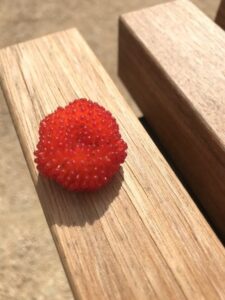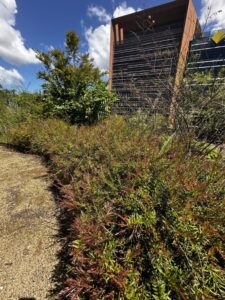
Bushfoods: The key to building nature-first cities
By Michael Casey
Bushfoods have long been valued for their cultural and culinary significance, but their true potential lies in how they can transform our cities. By choosing species that thrive in tough environments, we can create urban landscapes that are resilient, biodiverse and deeply connected to country.
The future of our cities will be shaped not only by how high our buildings rise, but by how well we integrate nature into the harshest and most unlikely places. Our cityscapes currently consist of rooftops exposed to blistering heat, podium landscapes balanced over concrete slabs, stormwater channels that swing between flood and drought, and verges where soils are compacted and stripped of nutrients. These are not easy environments for plants to survive, yet it is here in these difficult settings that green infrastructure must succeed if our urban centres are to become cooler, healthier and truly biodiverse.
Some of our bushfoods we have in cultivation may offer an exciting way forward. Too often they have been relegated to ornamental roles in private gardens, admired for their foliage or seasonal flowers, used for the commercial production of edibles but often overlooked for the ecological resilience and biodiversity benefits they bring. Species like warrigal greens, saltbush, wattle seed, lemon myrtle and finger lime are more than aesthetic additions. They are plants adapted to thrive in shallow soils, nutrient-poor conditions, or saline and compacted ground, conditions that are exactly the challenges posed by the built environment. By reframing bushfoods from garden novelties and commercial edibles to essential green infrastructure, we can unlock their potential to help cities function as living ecosystems.

This is not about a native-versus-exotic debate, but more about the plants’ attributes. With any garden design, and most importantly with green infrastructure, plants must be chosen for their ability to withstand the conditions into which they are to be planted. A rooftop garden, a rain garden, or a streetscape is no different to any other garden design, other than the fact that these environments are far less managed. Once established, they must survive in some cases with minimal intervention, and their value lies not in constant upkeep but in the ecological functions they provide; cooling, filtering water, supporting biodiversity and softening our built environments.
Provenance adds another layer of importance. A saltbush grown from seed collected in the same bioregion as the project site is far more likely to thrive and provide habitat for local pollinators than one grown from seed sourced hundreds of kilometres away. When bushfoods are selected with provenance in mind, they bring not only resilience but integrity, strengthening local ecosystems rather than replacing them with generic greenery.
And their role in biodiversity cannot be overstated. Bushfood species are food plants not just for us, but for the animals we need to welcome back into our cities. Finger limes attract pollinators and provide fruit that supports insects and birds. Wattles feed a wide range of wildlife with their seeds and flowers, creating stepping-stones for birds and small mammals across fragmented urban landscapes. Muntries and native raspberries offer nectar and fruit that feed insects, lizards, and parrots, while saltbush provides shelter for skinks and insects alongside its edible leaves. These plants bring back the interactions that are missing in concrete landscapes, allowing animals to return, breed, and thrive in urban corridors. A rooftop planted with warrigal greens or a streetscape lined with grevillea and wattles is not only greenery for people to enjoy, but also a pantry and shelter for biodiversity.

On rooftops with shallow substrates, bushfoods such as warrigal greens spread quickly, stabilising the surface and tolerating both heat and moisture stress. Finger lime and muntries can perform if deeper substrate pockets and irrigation are included in the design, rewarding the effort with edible harvests and seasonal habitat value. In stormwater channels, saltbush and wattles help filter and stabilise soils while withstanding periodic inundation. Lemon myrtle, with its aromatic foliage, brings resilience to nutrient-poor soils while adding sensory qualities that connect people to place. These plants are not just survivors; they are contributors that support wildlife and people alike.
The shift from ornamental use to infrastructure requires collaboration across the supply chain. Governments and councils can set frameworks that prioritise local provenance planting, developers and designers can specify bushfoods in their projects, and professional nurseries must have the capacity to grow them at scale. Without reliable supply, the ambition collapses. Bushfoods need to be available not as boutique offerings, but in commercial volumes ready for rooftops, streetscapes and public open spaces. For that, growers require early engagement and support from industry to scale up propagation systems and ensure diversity of species. Not only does support and policy assist in seeing more plants in our built environment, but the green infrastructure industry requires more time and projects to test these plants to ensure species will work in our built environment. This is where continuing partnerships with our academic sector assists.
Small-scale examples already hint at what is possible. Melbourne’s demonstration green roofs have tested the performance of native daisies and lomandras in shallow substrates, species that could easily be complemented by bushfoods such as warrigal greens or muntries. Rain garden projects trialling wattles and sedges for stormwater treatment hint at how saltbush or native mints could extend these benefits. While few large-scale examples currently exist, the hypothetical scenarios are easy to imagine, such as a hospital rooftop where bushfoods cool the building, feed pollinators and provide aromatic sensory experiences for patients, or suburban streets lined with wattles and finger limes that double as biodiversity corridors and local food sources.
The challenges of Australia’s numerous climatic zones and seasonal fluctuations, along with shallow soil profiles, compacted soils, and extreme heat are real, but they should not be seen as barriers. They are simply the parameters for good design. With bushfoods selected for their attributes, sourced from the right provenance and supported by collaborative supply chains, we can turn the grey, lifeless surfaces of our cities into functioning habitats.
Bushfoods are more than garden curiosities. They are a living bridge between culture, ecology, and urban life. By making them central to our plant palettes, we not only create resilient green infrastructure, we also create cities that feed and nurture the birds, insects, and animals we need back in our landscapes. In doing so, we make our urban places richer, healthier and unmistakably Australian.
Michael Casey
Director, Evergreen Infrastructure
Company Director, Australasian Green Infrastructure Network
Technical Panel, AIPH World Green Cities Awards
World Ambassador for World Green Roofs Day
E: michael@evergreeninfrastructure.com.au
